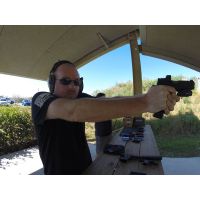Introducing a new shooter to firearms is a significant responsibility that involves careful planning and attention to detail, especially concerning safety and fundamental shooting skills.
Ensuring a positive and safe first experience is crucial to fostering proper respect for firearms and developing good shooting habits.
Here’s how to approach teaching someone to shoot for the first time.
Emphasize Safety First
Before handling any firearms, it's imperative to teach the four cardinal rules of firearms safety.


These rules are the backbone of safe firearm handling and should be understood and practiced at all times:
- Treat every gun as if it is loaded.
Always handle a firearm with the care you would if it were loaded. - Never point the firearm at anything you are not willing to destroy.
Always keep the muzzle pointed in a safe direction. - Keep your finger off the trigger until you are ready to shoot.
Your finger should rest along the side of the gun’s frame until you are prepared to fire. - Be sure of your target and what is beyond it.
Bullets can penetrate targets and walls, so knowing what’s behind your target is crucial.
Essential Safety Gear for New Shooters
Safety gear is an integral part of the shooting experience, especially for beginners who are just getting familiar with firearms.
Ensuring that all new shooters wear the proper safety gear can significantly mitigate the risk of accidents.
Here are the key types of safety gear that should always be used:
Eye Protection
Shooting can pose risks to your eyes from ejected shell casings, gunpowder residue, and potential debris from targets.
Protective eyewear should be worn at all times to shield your eyes from these hazards.
It's essential to choose shooting glasses that are:
Impact-resistant: Look for glasses that meet ANSI Z87.1 standards for safety, which ensure they can withstand the impact from most ricochets.
Wrap-around: Glasses that offer side protection can prevent debris from entering the eye from the periphery.
Appropriate for the environment: For outdoor shooting, consider sunglasses designed for shooting that can help reduce glare. For indoor ranges, clear lenses are typically more suitable.


The Wiley-X line of eye protection is my go-to eye protection because of their ANSI Z87.1 level of protection and their incredible value.
*Dating back to the early 1980s, Wiley X Eyewear is a prominent American manufacturer of protective eyewear, goggles, and sunglasses, renowned for its commitment to producing high-performance eyewear designed to meet the demands of various outdoor activities, sports, and occupational safety needs.
Hearing Protection
Guns are loud, with decibels ranging significantly depending on the caliber.
Regular exposure to gunshots can lead to permanent hearing loss, so effective hearing protection is critical.
There are two main types of hearing protection:
- Earplugs: Simple, inexpensive, and easy to use, earplugs can effectively protect against noise when inserted correctly.
They are available in disposable foam options or more durable materials for repeated use. - Earmuffs: These fit over the entire outer ear to form an air seal and provide excellent noise reduction.
Earmuffs can be combined with earplugs for enhanced protection, particularly in indoor environments or when using higher-caliber firearms.
For optimal protection, especially in the case of new shooters who might be more sensitive to the loud noises of gunfire, using both earplugs and earmuffs together is advisable.
This dual protection provides maximum reduction in noise exposure, safeguarding the shooter's hearing.


My number one choice for ear-pro on the range is the Walker's Game Ears Razor Digital over-the-ear muffs.
They are comfortable and quiet, but most importantly, they facilitate clear communication between instructor and student by enhancing conversation while blocking out loud gun shots.
*For over 25 years, Walkers Game Ear has been a leading brand in the hearing enhancement and protection industry, catering specifically to the needs of hunters, outdoors, and shooting sports enthusiasts with a variety of options.
By wearing proper eye and hearing protection, new shooters can focus on learning and enjoying the experience without the distraction or discomfort caused by safety concerns.
This not only makes the learning process safer but also more enjoyable, encouraging a positive first experience with shooting sports.
Starting with Smaller Calibers
Introducing a new shooter with a smaller caliber, such as .22LR Ammo, is widely recommended for several reasons:
- Manageability: The .22LR provides minimal recoil, making it easier for beginners to focus on their technique without flinching.
- Less Noise: Lower decibel levels reduce the intimidation factor and make the experience more comfortable.
- Cost-Effective: Ammunition for .22LR is cheaper, allowing for more extensive practice without a substantial financial burden.


Starting with high-power cartridges can be detrimental as it may instill a fear of shooting or lead to the development of poor habits like flinching, which can be difficult to correct later.
A firearm like the P322 from Sig Sauer (offered in a "P322 Tac Pac" with accessories) can make a great "gateway gun" to get a new shooter interested in going back to the range for more fun!
Teaching the Fundamentals
A proper introduction should cover the seven fundamentals of shooting.
Each should be explained and practiced to ensure the new shooter understands and can apply them effectively:
- Stance: The shooter's body must be positioned stably and comfortably, providing a strong base for shooting.
Common stances include Isosceles and Weaver. - Grip: Teach how to grip the firearm firmly with both hands to support and control the gun during firing.
- Sight Alignment: This involves aligning the front and rear sights correctly, crucial for accurate shooting.
- Sight Picture: Involves placing the aligned sights on the target in such a way that fosters accuracy.
- Breathing Control: Learning to control breath can help prevent unwanted movement.
Instruct to breathe normally and hold breath momentarily when preparing to shoot. - Trigger Control: Smooth and consistent pressure on the trigger should be taught to prevent jerking the gun.
- Follow Through: Staying focused on the target after the shot is fired to maintain accuracy, which helps in observing the shot impact and preparing for subsequent shots if needed.
By starting with these fundamentals, a new shooter can develop a strong foundation for safe and effective shooting practices.
This approach not only makes the learning process smoother but also ensures that bad habits are avoided right from the start.
Summary / Saved Rounds
Introducing someone to shooting is an enriching experience that can lead to a lifelong appreciation of the sport.
By focusing on safety, starting with manageable firearms like the .22LR, and carefully teaching the fundamentals of shooting, you can ensure a safe and positive experience for new shooters.
This responsible approach helps in cultivating skilled shooters who respect firearm safety and proficiency.In closing, my most important piece of advice is to be patient and understanding.
For many people, picking up a firearm for the first time can be an exciting and scary moment.
Help them learn that when respected carefully, firearms can be fun for sporting and recreation, and useful tools for self-defense.







